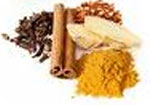| Tuesday, 13 May 2025 Home • About Us • Contact Us |
|
|
|
You are here:
Eating a diet rich in spices such as turmeric and cinnamon reduces the body's negative responses to eating high-fat meals, according to scientists.
A team of researchers has found a blend of antioxidant spices can reduce the stress that foods high in bad fats such as polyunsaturated fats, can place on the body, and on the heart in particular. When we eat, our bodies use carbohydrate calories for energy and turn leftover calories into triglycerides that are stored in fat cells for later use. These dietary fats have important uses in the body, but eating too much of the wrong types of fats can result in a build-up of oxidized fats in the body, leading to disease. See the article Good and Bad fats Explained. The study leader said:
The team prepared meals on two separate days for six men between the ages of 30 and 65 who were overweight, but otherwise healthy. The researchers added two tablespoons of culinary spices to each serving of the test meal, which consisted of chicken curry, Italian herb bread, and a cinnamon biscuit. The control meal was identical, except that spices were not included. The team drew blood from the participants every 30 minutes for three hours. In the spiced meal, they used rosemary, oregano, cinnamon, turmeric, black pepper, cloves, garlic powder and paprika. They selected these because they noted that these particular spices had potent antioxidant activity previously under controlled conditions in the lab. The spice dose provided the equivalent amount of antioxidants contained in 1.4oz of dark chocolate. When the meal contained a blend of antioxidant spices, antioxidant activity in the blood was increased by 13 per cent and insulin response decreased by about 20 per cent. High insulin levels can be toxic over time and cause a build-up of plaque in the arteries. "Antioxidants, like spices, may be important in reducing oxidative stress and thus reducing the risk of chronic disease," the researchers said. They noted that adding two tablespoons of spices to meals did not cause stomach upset in the participants. In the future, the team plans to investigate whether they can get the same results by adding smaller doses of spices to meals. Research Paper Details: Skulas-Ray A-C, Kris-Etherton PM, Teeter DL, et al. A High antioxidant Spice Blend Attenuates Postprandial Insulin and Triglyceride Responses and Increases Some Plasma Measures of antioxidant Activity in Healthy, overweight Men. Journal of nutrition, 2011; 141 (8): 1451.
Link to this article: Show: HTML Link • Full Link • Short Link
Related Articles:
You must be registered and logged in to comment. |
|
 |
 | |
|
|

 "Normally, when you eat a high-fat meal, you end up with high levels of triglycerides, a type of
"Normally, when you eat a high-fat meal, you end up with high levels of triglycerides, a type of 






